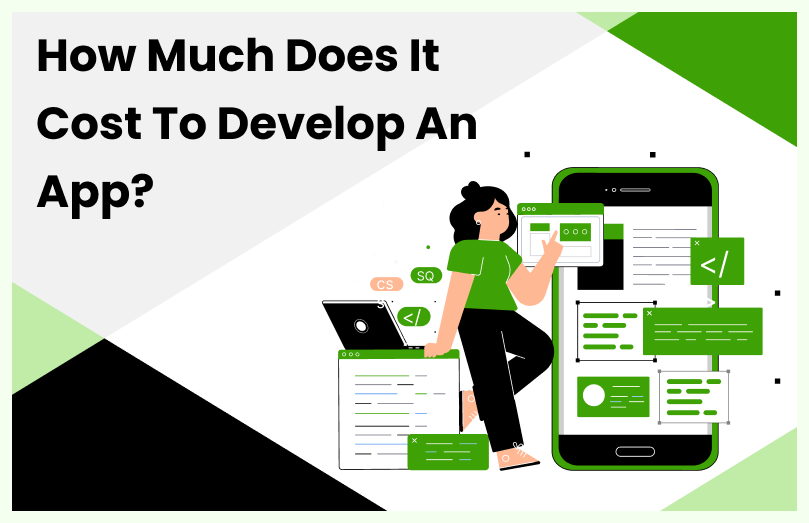Are you curious to know how much does app development costs? Mobile apps are essential to modern business strategies, with over 2.7 billion smartphone users worldwide. However, the cost of app development can be a significant barrier for many people. In this article, we’ll examine the various factors that impact mobile app development cost and provide a complete guide to help you understand the costs associated with developing a mobile app that will be successful. Let’s explore the exciting world of app development together!
How Much Does Mobile App Development Cost?
The cost of an application depends on many factors. However, we can summarize the following results based on a comprehensive survey.
In 2023, developing a basic app will range from $30,000 to $50,000. The development process usually takes about 4.5 to 11 weeks and includes essential features such as a user interface, simple functionalities, and user registration and login. Examples of simple apps are calculators, flashlights, and weather apps.
The cost of an application depends on many factors. However, we can summarize the following results based on a comprehensive survey.
- In 2023, developing a basic app will range from $30,000 to $50,000. The development process usually takes about 4.5 to 11 weeks and includes essential features such as a user interface, simple functionalities, and user registration and login. Examples of simple apps are calculators, flashlights, and weather apps.
- A complicated app could require $100,000 to $250,000 or more to develop in 2023. Complicated software is often created in 7 to 16 weeks and includes more sophisticated features, including third-party connections, real-time updates, push alerts, and extensive user interfaces. Social networking apps, e-commerce apps, and gaming apps are a few instances of complicated applications.
- The price to create a sophisticated app might be between $250,000 and $1,000,000 or higher. Sophisticated apps usually take 11.5 to 16 weeks to develop and have advanced features such as artificial intelligence, virtual reality, and machine learning. Examples of complicated apps include those used in healthcare, finance, and enterprise-level settings.
Factors Affecting the Price of Developing an App
It’s difficult to answer the query, “How much does it cost to build an app?” Seven crucial aspects determine the overall cost of producing an app:
- The cost differs depending on whether you choose internal development or outsourcing.
- Cost varies depending on the location and organizational structure of a development team.
- The cost of iOS development is less when compared with Android
- Hybrid vs. Native
- The visual design’s complexity.
- The cost varies depending on the backend infrastructure.
We’ll examine each of the determining factors in greater detail.
Choosing whether to construct an app internally or contract the task to a third-party development company is your priority.
One significant benefit of working with an internal development team is direct communication and total control over the team.
In-house Team Collaboration
Working with an internal team has advantages, such as:
- Proximity
- In-person meetings.
- Direct participation.
- Excellent control.
However, there is another perspective to consider:
- A shortage of skills in the area
- Need for substantial up-front investments
- Addressing recruiting and administrative issues
Outsourcing App Development
Working with an outsourcing business offers several advantages as well:
- Discrepancies in time zones
- Absence of personal control
However, because the advantages of outsourcing mobile app development outweigh the drawbacks, many businesses choose to do so. The following benefits of outsourcing app development:
- An endless pool of talent
- Highly skilled in the level of expertise
- Lower rates
- Greater flexibility
- Zero requirements of upfront cost
Before making a decision, evaluating both sides of the development process is essential.
What Factors Contribute to the Custom App Development Cost?
Let’s look at how the app development cost is determined:
1. Development Team’s Location and Structures
You must select a nation if you intend to outsource the development of your app. There are a few choices available:
- Nearshore outsourcing refers to partnering with a firm in your country or a neighboring one, where there is only a 2- to 4-hour time difference.
- Remote collaboration with a corporation is called offshore outsourcing, which involves working across four different time zones.
Outsourcing your development team has challenges, including the time difference that can hinder communication. However, the financial advantages often outweigh these difficulties, so many businesses opt for this approach. If you want to ensure effective communication and timely project completion, consider selecting a country with a few hours of overlap in work hours with your team.
2. Hybrid vs Native App Development
To accurately answer the question “How much does it cost to build an app?” you need to know the type of app you want to create. You can create a native or hybrid app, depending on your specific needs.
A native app is designed for either an iOS or Android platform. Creating two separate applications is necessary if you want to target both groups, but it can significantly increase the cost of app development.
Developing a hybrid app comprises making an application that will run on many operating systems. The decreased development costs of these apps are their crucial benefit. Businesses often prefer native apps due to the drawback of hybrid applications. Inconsistent performance, device-dependent user interfaces, and technological limitations are some of the challenges they face.
3. App Development for Android and iOS
Android and iOS are the two most widely used mobile operating systems globally, so it’s best to focus on developing an app for one of these platforms.
You could go over and above and make an app for each platform. You may start with an app for just one platform, such as iOS or Android, to test your concept without taking a significant financial risk.
What are the costs associated with iOS or Android platforms?
Given that both forms of development take roughly the same amount of time, the prices are not much different. If you had more money, you could concurrently develop and release two programmes.
4. Customizing Visual Design for Individuals
The design of your app is the first thing that catches consumers’ attention when they launch it. You can make an excellent first impression or risk losing their interest.
When designing the UX and UI for your app, you can expect to pay $5,000 or more for 10-20 screens. The cost can vary based on factors such as the number of screens, the level of visual complexity, the need for custom features, intricate artwork, and branding.
5. Mobile App Maintenance Cost
Maintaining an app depends on its complexity, user base, and required frequency of updates. Some apps may require more frequent upgrades and ongoing support, resulting in higher maintenance costs. These costs are typically calculated as a percentage of the initial development cost, averaging between 15% and 20% per year.

6. Features
The features included in a mobile app heavily impact its development cost. More functionality requires more resources and investment. In-app purchases, social network integration, real-time chat, and location-based services are a few standard features that might raise the development cost. The complexity of the implementation and the level of customization required will determine “how much does it cost to develop an app”.
7. Functionalities
The cost of creating a mobile app is affected by its features, which include push notifications, offline access, user authentication, and data storage.
Mobile App Development Costs: Calculation
Calculating the cost of developing an app on your own is simple. To calculate the project’s total cost, multiply the hourly rate by the required hours. It will give you an estimate of the total cost breakdown for app development. Most businesses provide an estimated cost for mobile app development before the building stage begins, allowing you to plan and budget appropriately.
Most app development companies usually opt for one of two pricing strategies:
- Fixed Fee: This approach is commonly used for brief projects with a specific deadline and a predetermined scope of work. With this method, you know the total cost before the development process commences, so you don’t have to fret over the expenses of building an app. This calculation method’s main advantage is its transparency in app development costs.
- Time and Materials: This pricing strategy is more flexible than the first. It is usually used for complex projects that might experience unexpected delays during development. The price is determined based on the number of hours spent on development and the hourly rate.
While the time and material strategy might be problematic, it has many benefits. The project’s cost won’t change throughout development with the fixed pricing method. You can modify the scope of work and add or remove features, even during the development process, as long as it falls within the agreed time & material range. It allows for the creation of personalized software that meets the customers’ preferences.
Conclusion
Developing a mobile app can cost different amounts depending on the platform, features, and functionalities needed. Working with an experienced app development team to guide you through the process is essential to make informed decisions about your project. At MMF Infotech, we provide React Native app development services to help you create a custom app that meets your needs and budget. Get in touch with us today to get your vision turned into reality.


